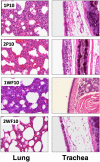Compatibility of H9N2 avian influenza surface genes and 2009 pandemic H1N1 internal genes for transmission in the ferret model
- PMID: 21730147
- PMCID: PMC3141953
- DOI: 10.1073/pnas.1108058108
Compatibility of H9N2 avian influenza surface genes and 2009 pandemic H1N1 internal genes for transmission in the ferret model
Abstract
In 2009, a novel H1N1 influenza (pH1N1) virus caused the first influenza pandemic in 40 y. The virus was identified as a triple reassortant between avian, swine, and human influenza viruses, highlighting the importance of reassortment in the generation of viruses with pandemic potential. Previously, we showed that a reassortant virus composed of wild-type avian H9N2 surface genes in a seasonal human H3N2 backbone could gain efficient respiratory droplet transmission in the ferret model. Here we determine the ability of the H9N2 surface genes in the context of the internal genes of a pH1N1 virus to efficiently transmit via respiratory droplets in ferrets. We generated reassorted viruses carrying the HA gene alone or in combination with the NA gene of a prototypical H9N2 virus in the background of a pH1N1 virus. Four reassortant viruses were generated, with three of them showing efficient respiratory droplet transmission. Differences in replication efficiency were observed for these viruses; however, the results clearly indicate that H9N2 avian influenza viruses and pH1N1 viruses, both of which have occasionally infected pigs, have the potential to reassort and generate novel viruses with respiratory transmission potential in mammals.
Conflict of interest statement
The authors declare no conflict of interest.
Figures




References
-
- Alexander DJ. A review of avian influenza in different bird species. Vet Microbiol. 2000;74:3–13. - PubMed
-
- Lee CW, et al. Sequence analysis of the hemagglutinin gene of H9N2 Korean avian influenza viruses and assessment of the pathogenic potential of isolate MS96. Avian Dis. 2000;44:527–535. - PubMed
-
- Naeem K, Ullah A, Manvell RJ, Alexander DJ. Avian influenza A subtype H9N2 in poultry in Pakistan. Vet Rec. 1999;145:560. - PubMed
-
- Perk S, et al. Ecology and molecular epidemiology of H9N2 avian influenza viruses isolated in Israel during 2000–2004 epizootic. Dev Biol (Basel) 2006;124:201–209. - PubMed
-
- Matrosovich MN, Krauss S, Webster RG. H9N2 influenza A viruses from poultry in Asia have human virus-like receptor specificity. Virology. 2001;281:156–162. - PubMed
Publication types
MeSH terms
Substances
Grants and funding
LinkOut - more resources
Full Text Sources
Other Literature Sources

